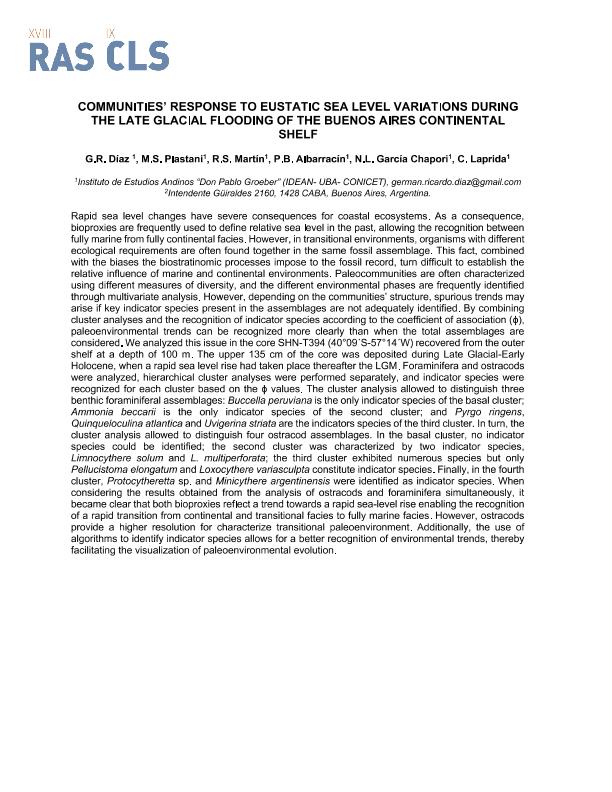Evento
Communities’ response to eustatic sea level variations during the late glacial flooding of the buenos aires continental shelf
Díaz, Germán Ricardo ; Plastani, María Sofía
; Plastani, María Sofía ; Martín, Rodrigo Sebastian
; Martín, Rodrigo Sebastian ; Albarracin, Paula Belen
; Albarracin, Paula Belen ; García Chapori, Natalia Luz
; García Chapori, Natalia Luz ; Laprida, Cecilia
; Laprida, Cecilia
 ; Plastani, María Sofía
; Plastani, María Sofía ; Martín, Rodrigo Sebastian
; Martín, Rodrigo Sebastian ; Albarracin, Paula Belen
; Albarracin, Paula Belen ; García Chapori, Natalia Luz
; García Chapori, Natalia Luz ; Laprida, Cecilia
; Laprida, Cecilia
Tipo del evento:
Reunión
Nombre del evento:
XVIII Reunión Argentina de Sedimentología y IX Congreso Latinoamericano de Sedimentología
Fecha del evento:
19/09/2023
Institución Organizadora:
Asociación Argentina de Sedimentología;
Título del Libro:
Actas de la XVIII Reunión Argentina de Sedimentología y IX Congreso Latinoamericano de Sedimentología
Editorial:
Asociación Argentina de Sedimentología
ISBN:
978-631-90299-0-1
Idioma:
Inglés
Clasificación temática:
Resumen
Rapid sea level changes have severe consequences for coastal ecosystems. As a consequence, bioproxies are frequently used to define relative sea level in the past, allowing the recognition between fully marine from fully continental facies. However, in transitional environments, organisms with different ecological requirements are often found together in the same fossil assemblage. This fact, combined with the biases the biostratinomic processes impose to the fossil record, turn difficult to establish the relative influence of marine and continental environments. Paleocommunities are often characterized using different measures of diversity, and the different environmental phases are frequently identified through multivariate analysis. However, depending on the communities’ structure, spurious trends may arise if key indicator species present in the assemblages are not adequately identified. By combining cluster analyses and the recognition of indicator species according to the coefficient of association (ϕ), paleoenvironmental trends can be recognized more clearly than when the total assemblages are considered. We analyzed this issue in the core SHN-T394 (40°09´S-57°14´W) recovered from the outer shelf at a depth of 100 m. The upper 135 cm of the core was deposited during Late Glacial-Early Holocene, when a rapid sea level rise had taken place thereafter the LGM. Foraminifera and ostracods were analyzed, hierarchical cluster analyses were performed separately, and indicator species were recognized for each cluster based on the ϕ values. The cluster analysis allowed to distinguish three benthic foraminiferal assemblages: Buccella peruviana is the only indicator species of the basal cluster; Ammonia beccarii is the only indicator species of the second cluster; and Pyrgo ringens, Quinqueloculina atlantica and Uvigerina striata are the indicators species of the third cluster. In turn, the cluster analysis allowed to distinguish four ostracod assemblages. In the basal cluster, no indicator species could be identified; the second cluster was characterized by two indicator species, Limnocythere solum and L. multiperforata; the third cluster exhibited numerous species but only Pellucistoma elongatum and Loxocythere variasculpta constitute indicator species. Finally, in the fourth cluster, Protocytheretta sp. and Minicythere argentinensis were identified as indicator species. When considering the results obtained from the analysis of ostracods and foraminifera simultaneously, it became clear that both bioproxies reflect a trend towards a rapid sea-level rise enabling the recognition of a rapid transition from continental and transitional facies to fully marine facies. However, ostracods provide a higher resolution for characterize transitional paleoenvironment. Additionally, the use of algorithms to identify indicator species allows for a better recognition of environmental trends, thereby facilitating the visualization of paleoenvironmental evolution.
Palabras clave:
Paleoceanografía
,
Paleoecología
,
Foraminífera
,
Ostracoda
Archivos asociados
Licencia
Identificadores
Colecciones
Eventos(IDEAN)
Eventos de INSTITUTO DE ESTUDIOS ANDINOS "DON PABLO GROEBER"
Eventos de INSTITUTO DE ESTUDIOS ANDINOS "DON PABLO GROEBER"
Citación
Communities’ response to eustatic sea level variations during the late glacial flooding of the buenos aires continental shelf; XVIII Reunión Argentina de Sedimentología y IX Congreso Latinoamericano de Sedimentología; La Plata; Argentina; 2023; 121-121
Compartir



